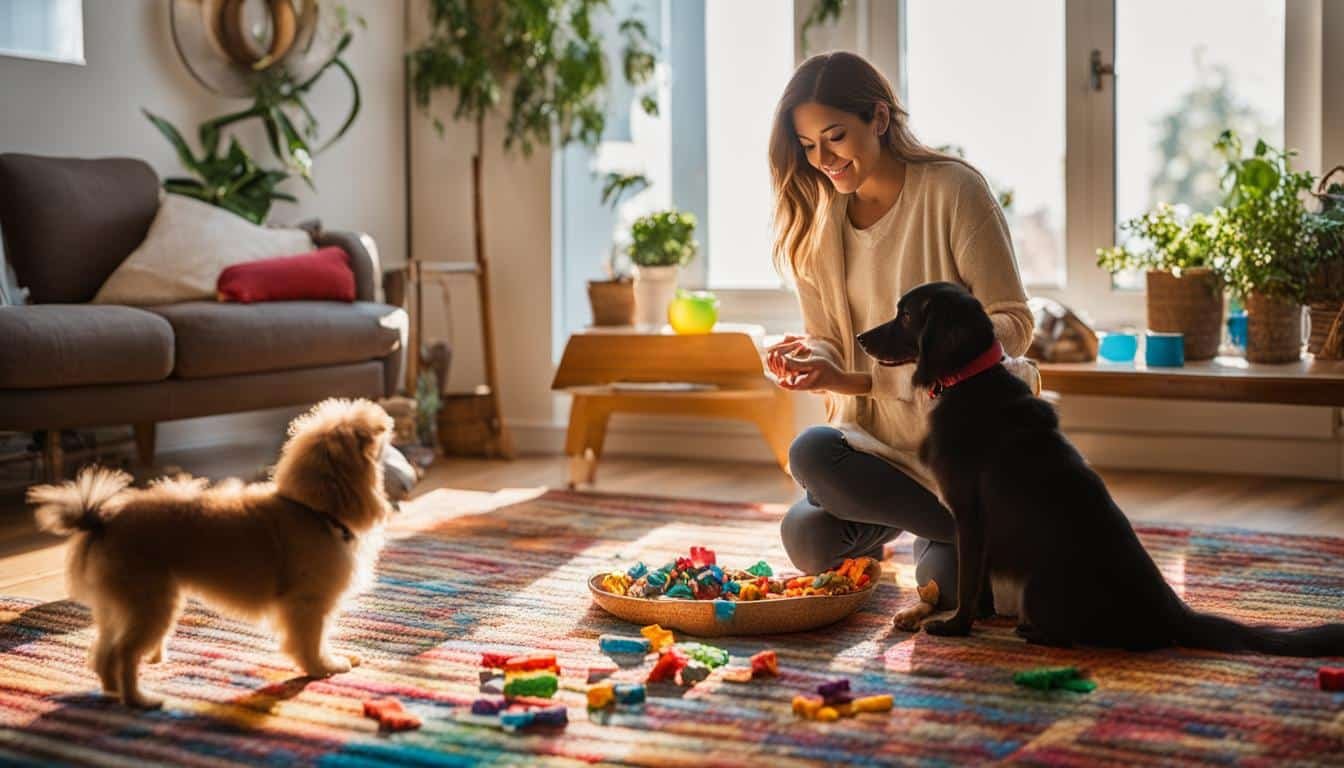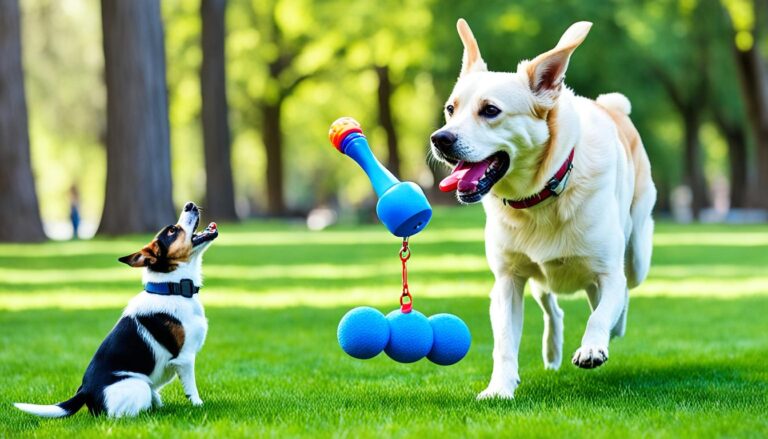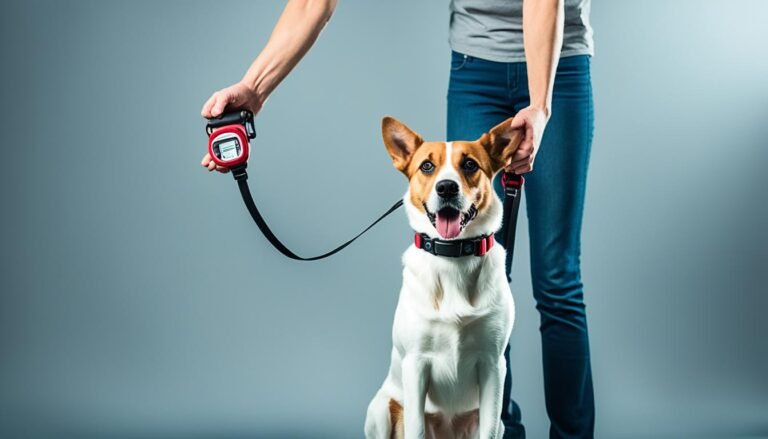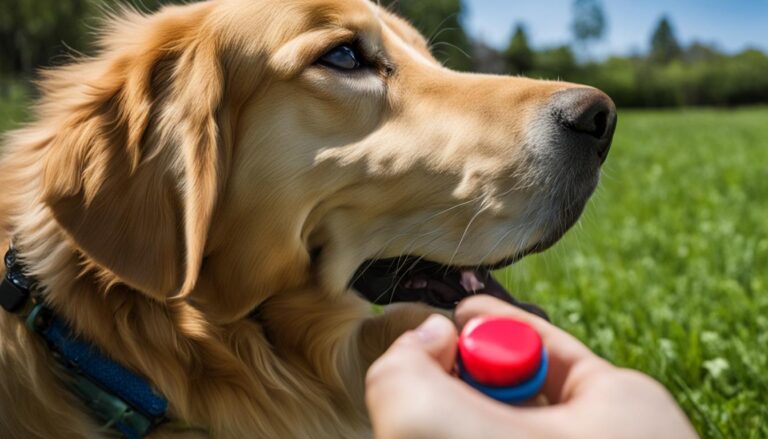Can I Train My Dog Myself?
Are you wondering if you have what it takes to train your dog at home? Many pet owners have asked themselves the same question. The good news is, with the right knowledge and techniques, you can absolutely train your dog on your own. DIY dog training offers a unique opportunity for you to build a close bond with your pet while being in control of the entire training process.
Training your dog at home can be a rewarding and fulfilling experience, but it’s not without its challenges. It requires time, patience, consistency, and a good understanding of the right training techniques. You’ll need to invest your time and effort into teaching your dog to follow your commands and develop desirable behaviors.
While hiring a professional trainer may be an option, it can be expensive and may not fit everyone’s budget. Training your dog yourself allows you to have a closer relationship with your pet and be the primary person they respond to. Plus, self-training can be a cost-effective alternative.
However, it’s important to note that dog training requires precision, consistency, and the right practices. If you lack the knowledge or time to be consistent, it may be best to seek professional help. A professional trainer can teach you the necessary techniques and help you establish a strong foundation for training your dog.
So, whether you choose to train your dog at home or seek professional guidance, it ultimately depends on your availability, resources, and goals for training your dog. In the following sections, we’ll explore the benefits of training your dog yourself, considerations for DIY dog training, techniques you can use, and when it might be best to hire a professional trainer.
If you’re ready to take on the challenge and train your dog independently, let’s dive deeper into the world of DIY dog training techniques and how they can benefit both you and your furry friend.
The Benefits of Training Your Dog Yourself
Training your dog yourself can be a rewarding and fulfilling experience for both you and your furry companion. By taking on the role of a trainer, you have the opportunity to develop a strong bond and build trust with your dog. This personalized approach to training allows you to tailor your methods and techniques to match your dog’s unique temperament and learning style.
One of the key benefits of self-training is that you are in complete control of the training process and the outcomes. You can set the pace, focus on specific areas of improvement, and celebrate your dog’s progress and successes along the way. Spending quality time with your dog during training sessions not only strengthens your bond but also deepens your understanding of their behavior.
With independent dog training, you have the freedom to address any specific issues or challenges your dog may have. Whether it’s overcoming separation anxiety, reducing excessive barking, or reinforcing good manners, you can focus on the areas that require attention. This personalized approach allows you to provide targeted solutions that are tailored to your dog’s needs.
Through self-training, you can witness the growth and development of your dog firsthand. Seeing them master new commands or overcome behavioral challenges under your guidance brings a sense of satisfaction and accomplishment. It’s a journey of continuous learning and growth, both as a dog owner and a trainer.
By training your dog yourself, you also strengthen the bond and communication between you and your pet. Your dog learns to trust and rely on you as their primary source of guidance and instruction. This mutual understanding and cooperation form the foundation of a positive and respectful relationship.
To enhance the effectiveness of your self-training, remember to consistently use positive reinforcement techniques. Reward your dog with treats, praise, and affection when they exhibit desired behavior. This positive approach creates a joyful and engaging learning environment, making the training experience enjoyable for both you and your dog.
Training your dog yourself allows you to fully engage in their development and make training a personalized and enjoyable experience. It’s an opportunity to strengthen your bond, build trust, and create a harmonious relationship with your beloved canine companion.
Considerations for DIY Dog Training
When it comes to training your dog yourself, there are several important factors to consider. DIY dog training can be a rewarding experience, but it requires certain considerations to ensure success.
Time Commitment
Training your dog yourself requires a significant time commitment. It is not a quick process, and consistency is key. Dogs may not pick up on commands right away, so you need to be patient and persistent in your training efforts.
Knowledge and Resources
Having the necessary knowledge and understanding of proper training techniques is crucial. You should invest time and effort into learning about your dog’s behavior and training methods. Additionally, DIY dog training requires resources such as training aids, treats, and training materials.
Availability and Consistency
Assess your availability and ensure that you can dedicate sufficient time to training your dog consistently. Dogs thrive on routine, so it’s essential to establish consistent training sessions to reinforce desired behaviors.
Potential Limitations
Consider any limitations or challenges you may have that could affect your ability to train your dog effectively on your own. These could include physical limitations, lack of experience, or other responsibilities that may impact your training sessions.

Seeking Guidance
While DIY dog training can be done independently, seeking guidance from reputable sources or professionals can be beneficial. They can provide expert advice, support, and ensure you are on the right track with your training.
By taking these considerations into account, you can make an informed decision about whether DIY dog training is the right path for you and your furry friend.
DIY Dog Training Techniques
When it comes to training your dog yourself, there are several techniques you can use to achieve the desired results. These DIY dog training techniques are not only effective but also help you establish a stronger bond with your furry companion. Let’s explore some of the key techniques:
1. Positive Reinforcement
Positive reinforcement is a powerful training method that involves rewarding your dog’s desirable behaviors with treats, praise, or play. By focusing on positive reinforcement, you encourage your dog to repeat these behaviors, making the training process more enjoyable for both of you.
2. Clicker Training
Clicker training is a popular technique that utilizes a clicker device to mark desired behaviors. Each time your dog performs a behavior you want to reinforce, you use the clicker to create an association between the behavior and a reward. Clicker training helps your dog understand precisely what they’re doing right, making it easier to reinforce positive behaviors.
3. Teaching Basic Commands
Teaching your dog basic commands is an essential part of DIY dog training. Commands like sit, stay, down, and come are not only useful for everyday interactions, but they also promote obedience and discipline. Start with one command at a time and be consistent with your training sessions.
4. Leash Training
Leash training is crucial for ensuring that your dog walks safely and comfortably by your side. It involves teaching your dog to walk on a leash without pulling or lunging. With patience and consistent training, you can gradually introduce your dog to the leash and teach them to walk calmly by your side.
5. Socialization
Socialization is a vital aspect of DIY dog training, as it helps your dog become comfortable and well-behaved around people and other animals. Expose your dog to various environments, people, and animals, and reward them for positive interactions. Gradually increase the level of exposure over time to ensure proper socialization.
6. Proofing Behaviors
Proofing behaviors involves practicing commands and behaviors in different environments and situations to ensure your dog’s reliability. Gradually increase distractions and challenges as your dog becomes more proficient in their training. This technique helps reinforce your dog’s understanding and compliance with commands under various circumstances.
Remember, these DIY dog training techniques require consistency, repetition, and positive reinforcement to reinforce desired behaviors. Set realistic goals, break down the training into manageable steps, and be patient with your furry companion. With dedication and love, you can achieve successful results in training your dog yourself.

When to Consider Hiring a Professional Trainer
If you find yourself struggling with time constraints and unable to dedicate sufficient time to training your dog, it might be worth considering hiring a professional trainer. Lack of knowledge or experience in dog training techniques can also pose challenges when attempting to achieve desired results on your own. A professional trainer can provide the expertise and guidance needed to address specific behavior issues that may require specialized training. Whether it’s aggression, separation anxiety, or fear-based behaviors, a professional trainer can offer personalized training plans and techniques tailored to your dog’s specific needs.
If you prefer professional guidance and support throughout the training process, hiring a trainer can provide reassurance and peace of mind. They can offer objective feedback and advice on your training progress and make necessary adjustments as needed. With their specialized training knowledge, professional trainers can ensure that your dog receives the most effective and efficient training. However, it’s important to note that professional training comes at a cost, so it’s essential to weigh the financial implications against the benefits you’ll receive.
Ultimately, the decision to hire a professional trainer depends on your individual circumstances, goals, and resources. If you feel overwhelmed by time constraints, lack the necessary knowledge, or need help with specific behavior issues, seeking professional guidance can be the right choice for you and your dog. Remember that the well-being and success of your dog’s training should always be the top priority.
Benefits of Hiring a Professional Trainer
- Expertise in addressing specific behavior issues
- Personalized training plans tailored to your dog’s needs
- Objective feedback and guidance throughout the training process
- Efficiency and effectiveness in achieving training goals
- Peace of mind and reassurance
The Importance of a Strong Bond
Building a strong bond with your dog is crucial for effective training and overall well-being. When you establish a strong bond with your canine companion, it fosters trust, creating a positive training environment. Good communication between you and your dog is key to successful training, and a strong bond enhances this communication.
By investing time and effort into developing a deep companionship and understanding with your dog, you contribute to a positive and fulfilling relationship. A strong bond allows you to establish mutual respect and cooperation, enabling you to navigate through various training challenges together.
Dogs are social animals, and a robust bond enhances their emotional well-being and overall quality of life. Therefore, building a strong bond with your dog is not only important for training purposes but also for their overall happiness and contentment.
Building a strong bond requires consistent effort and the use of effective training techniques. Through daily interaction, positive reinforcement, and lots of love and attention, you can forge a deep bond with your four-legged friend. This strong connection will make your training sessions more enjoyable and successful.
By prioritizing the bond with your dog, you establish a foundation of trust that strengthens your relationship and enhances your ability to communicate. In return, your dog will be more responsive to your training cues and commands, resulting in a well-trained and obedient pet.
Finding Support and Resources for DIY Dog Training
When it comes to DIY dog training, having access to reliable support and resources is essential. Whether you’re looking for expert advice, step-by-step guides, or a community of like-minded dog owners, there are plenty of options available to help you on your training journey.
Online Resources
Online resources are a treasure trove of information for DIY dog training. Platforms like YouTube, articles, and blogs offer a wide range of tutorials, tips, and demonstrations for various training exercises. You can find step-by-step guides to teach your dog basic commands, address specific behavior issues, and even learn advanced training techniques. The convenience and accessibility of online resources make them a valuable tool for dog owners seeking to train their dogs independently.
Dog Training Classes
If you prefer a more structured learning environment and professional guidance, dog training classes or obedience classes can be a great option. These classes offer a hands-on experience with qualified trainers who can provide personalized advice and assistance for your specific training needs. In a class setting, you’ll have the opportunity to learn from experienced professionals, practice training exercises with other dogs, and receive immediate feedback on your progress. It’s a fantastic way to enhance your training skills while building a stronger bond with your furry friend.
Professional Advice
When it comes to dog training, sometimes you need the expertise and insight of a professional trainer. If you find yourself facing unique challenges or behavior issues that require specialized training, seeking professional advice is highly recommended. Professional trainers equipped with years of experience and knowledge can provide you with personalized training plans and techniques tailored to your dog’s specific needs. Look for trainers who emphasize positive reinforcement techniques, as this approach focuses on building a trusting and positive relationship with your dog.
Support Groups
Joining support groups or online communities of dog owners can be incredibly beneficial for DIY dog trainers. These groups provide a network of support, where you can connect with other dog owners who are also training their dogs independently. It’s an opportunity to share experiences, seek guidance, and gain valuable insights from those who have been through similar training journeys. Being part of a support group allows you to feel encouraged, motivated, and understood as you navigate the challenges and successes of training your dog.
In conclusion, when it comes to DIY dog training, finding the right support and resources is crucial. Online resources, dog training classes, professional advice, and support groups all play a vital role in helping you achieve your training goals. Take advantage of these valuable tools to enhance your training skills, deepen your bond with your dog, and foster a happy and well-behaved canine companion.
The Decision: DIY or Professional Training?
When it comes to training your dog, you have a few options to consider. DIY dog training allows you to take control of the process, build a strong bond with your pet, and tailor the training to your dog’s specific needs. On the other hand, hiring a professional trainer can provide expert guidance, specialized techniques, and save you time and effort. So, how do you decide which approach is right for you?
Start by weighing the options based on your personal circumstances and goals. Assess your availability and time commitment. DIY training requires consistent effort and patience, so make sure you have the time to dedicate to the process. Consider your comfort level with training techniques and your willingness to learn. If you prefer a hands-on approach and have a desire to develop your training skills, DIY training may be a great fit.
Evaluate your resources, including your financial capabilities and access to training materials. DIY training can be more cost-effective, as you won’t have to pay for professional services. However, keep in mind that some behavior issues may require specialized training from a professional. Reflect on your relationship with your dog and how each approach can enhance it. Some dog owners value being the primary person their dog responds to, while others appreciate the professional guidance and support.
Ultimately, the decision between DIY and professional training depends on your individual preferences and what works best for you and your dog. Prioritize your dog’s well-being, safety, and happiness throughout the training process. Choose an approach that aligns with your values, goals, and level of commitment. Remember, whether you choose the DIY route or opt for professional training, the most important thing is to ensure a positive training experience for you and your furry friend.






